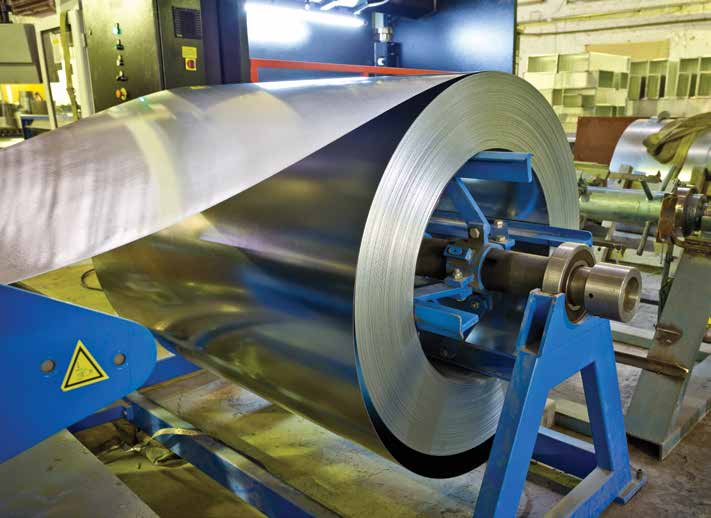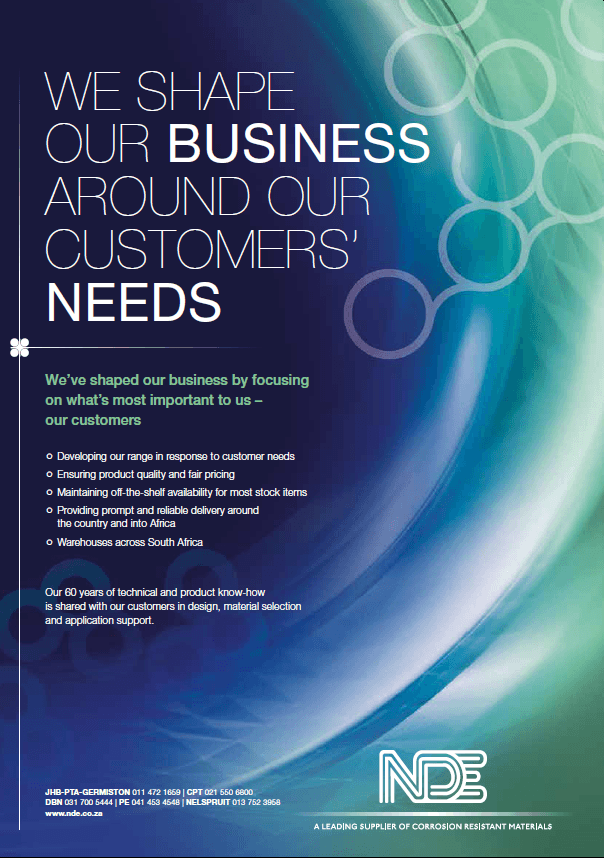Chinese stainless steel company believes it can produce ferritics at a better cost than galvanised steel
Sassda Executive Director John Tarboton recently presented a paper at the International Chromium Developments Association’s (ICDA) annual conference “Chromium 2017” on the South African stainless steel industry and what Sassda is doing to develop this market. At the conference, two papers were presented on technology disruption in the stainless steel industry.
THE FUTURE

The proposed Chinese plant will be optimised for ferritic backend integration into the ferrochrome and iron plants
The first paper, from Outotec, Finland, focussed on lowering the cost of production of austenitic stainless steel. It was titled “Ferrochromenickel – Disruptive Innovation for the Stainless Steel Value Chain”. The idea is to combine the ferrochrome (FeCr) and nickel (Ni) production routes to produce liquid Ferrochromenickel (FeCrNi) and eliminate the nickel refining step. This process also results in higher yields for metals (chromium, nickel and iron) and a lower energy consumption (15% to 35% lower than FeCr plus Ni or FeNi as separate production routes).
The second presentation was by Mintal Group, China on “Yesterday, Today and Tomorrow of the Chinese FeCr Industry”.
The last slide had only ten words – “What is our target? Make stainless steel replace carbon steel”.
The breakthrough technology here is producing ferritic stainless steels for less than the cost of galvanised steel – in other words, a superior product for a lower price. The galvanised steel market in China alone consists of 64 million tonnes. To put this into perspective, the entire world’s production of stainless steel was just over 45 million tonnes in 2016, with China producing 54% of this. The company also plans to target the coloured steel sheet market in China, which is about 25 million tonnes.

The proposed Chinese plant will be optimised for ferritic backend integration into the ferrochrome and iron plants
A new stainless steel plant will start producing 2.5 million tonnes of stainless steel within the next two years – and this is just the start. This will be a dedicated ferritic stainless steel plant with backward integration into the ferrochrome plant and iron plant. The idea is to have liquid ferrochrome and liquid iron transfer into a plant optimised for ferritic stainless steel production.
There was not much detail on how a ferritic-only plant would differ from a multi-purpose plant, such as Columbus Stainless, but the presenter was adamant that the process and cost technologies were proven and that the plant was currently being built. He emphasised that process steps need to be combined and reheating avoided wherever possible. This new plant will produce stainless steel with much lower energy requirements and will thus be an environmentally friendly plant to comply with stricter Chinese laws.
THE PAST
But this is not new, as backwards integration and technologies to optimise the process costs from chromite ore to stainless steel sheet have been trialled and implemented for decades in South Africa. Certainly, the excellent book, “The Chrome Connection – A Commemorative History of Middelburg Steel & Alloys” shows that RMB (which later became Southern Cross, MS&A and then Columbus Stainless) early on realised the importance of beneficiation rather than selling chromite ore for minimum value-add to the country.
The Alloys division of MS&A had a long history of process innovation culminating in the CDR (Chromium Direct Reduction) Project in 1990, although ultimately the CDR turned out to be bleeding edge, rather than leading edge technology. With the sale of MS&A Chromium to Samancor, the project was abandoned.
Stainless steel production began in Middelburg in 1966 and a few years later it was realised that austenitic stainless steel was costly, due to the nickel and the dream was born of making nickel-free stainless steel that could be sold in direct competition to mild steel. It was predicted at the time that eventually ferritic stainless steel would replace mild steel in many of its applications. In 1977, MS&A invented 3CR12 and this dream started to be realised.
The official launch of 3CR12 came at the end of March 1981 and John Hall (MS&A Chairman) was quoted as predicting that “in the next ten years the new product could double world consumption of stainless steel”. This turned out to be overly optimistic but by the early 1990s, the composition was optimised to reduce alloying costs and process costs. Tony Bagnall, MS&A Manager, Steel Research and Technical Development, had initiated the idea of removing the expensive titanium and nickel from the initial 3CR12 with a tweak on the manganese and nitrogen.
This brought the cost down significantly, improved the surface quality and reduced process costs by self-annealing. Jack Hewitt, MS&A R&D Manager and Tony Bagnall were the ones pushing this to allow 3CR12 to become more competitive with mild steel.
At the INFACON conference in 1992, Jack Hewitt promoted the idea of 3CR12 achieving a one percent penetration of the carbon steel market and noted that this would result in a doubling of world stainless steel production and associated chromium supplies. At the same conference, Don Maxwell, MS&A 3CR12 International Manager, believed that it was theoretically possible to produce 3CR12 at the base carbon steel price plus the cost of the chromium.
THE PRESENT
So, what is the current state of the stainless steel industry in South Africa?
Primary production (sheet, plate and coil) is approximately 500 000 tonnes, which at an average selling price of about $2 200/tonne is worth about $1.1bn (R15bn). Apparent Consumption (roughly equivalent to the amount of primary product converted to finished product) is approximately 140 000 tonnes and this conversion adds value of about $600m (R8bn). At three to five tonnes per worker, this conversion industry accounts for approximately 35 000 direct jobs.
However, there is a multiplier effect. From work done in South Africa by the Department of Science and Technology, this would mean an additional 70 000 jobs and a value of about $1bn (R13bn) in extra support industries and services.
This means a total value of the stainless steel value chain from primary production to finished product production of $2.7bn (R36bn) employing about 100 000 people.
According to the International Chromium Development Association (ICDA), South Africa and Zimbabwe hold about 90% of the world’s chromite reserves and resources. The problem is that FeCr production consumes a lot of electricity. Mintal, who gave the presentation at Chromium 2017, say they pay $0.06/ kWh (R0.82/kWh). It is thus critical for the growth of the chromium beneficiation value-chain in South Africa that future electricity price increases are constrained.
The importance of chromium beneficiation was highlighted by a media announcement on 5 March 2017 on developments in the Musina-Makhado Special Economic Zone (MMSEZ). It was proposed that the Metallurgical Industrial Complex include a one million tonne stainless steel plant. The operator agreement has been signed between the MMSEZ and Shenzhen Hoimor Resources Holding Company Limited, which consists of a consortium of Chinese investors.
They will develop, operate and manage the energy and metallurgical cluster. The company specialises in mineral beneficiation and is also the anchor investor in the SEZ. They will invest $3.8 billion into this SEZ.
This could be an ideal opportunity to develop a dedicated ferritic stainless steel plant that is fully backward integrated into ferrochrome and iron production, with liquid metal transfer of both into the stainless steel plant. Who knows, this may result in realising the dream of those people in the South African stainless steel industry all those years ago.


